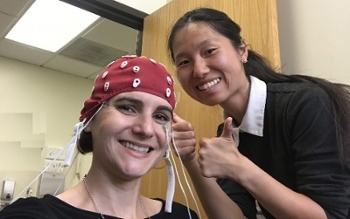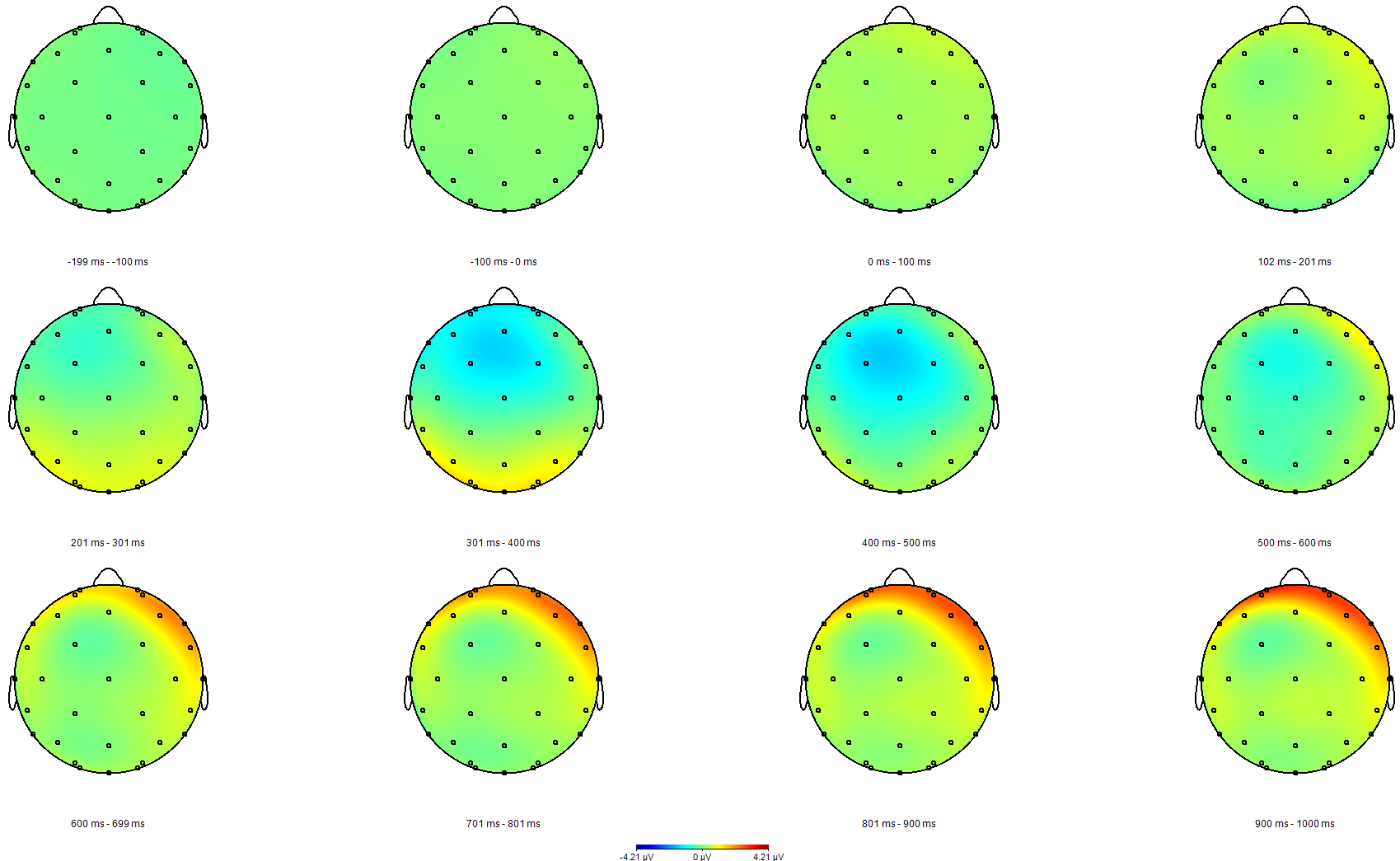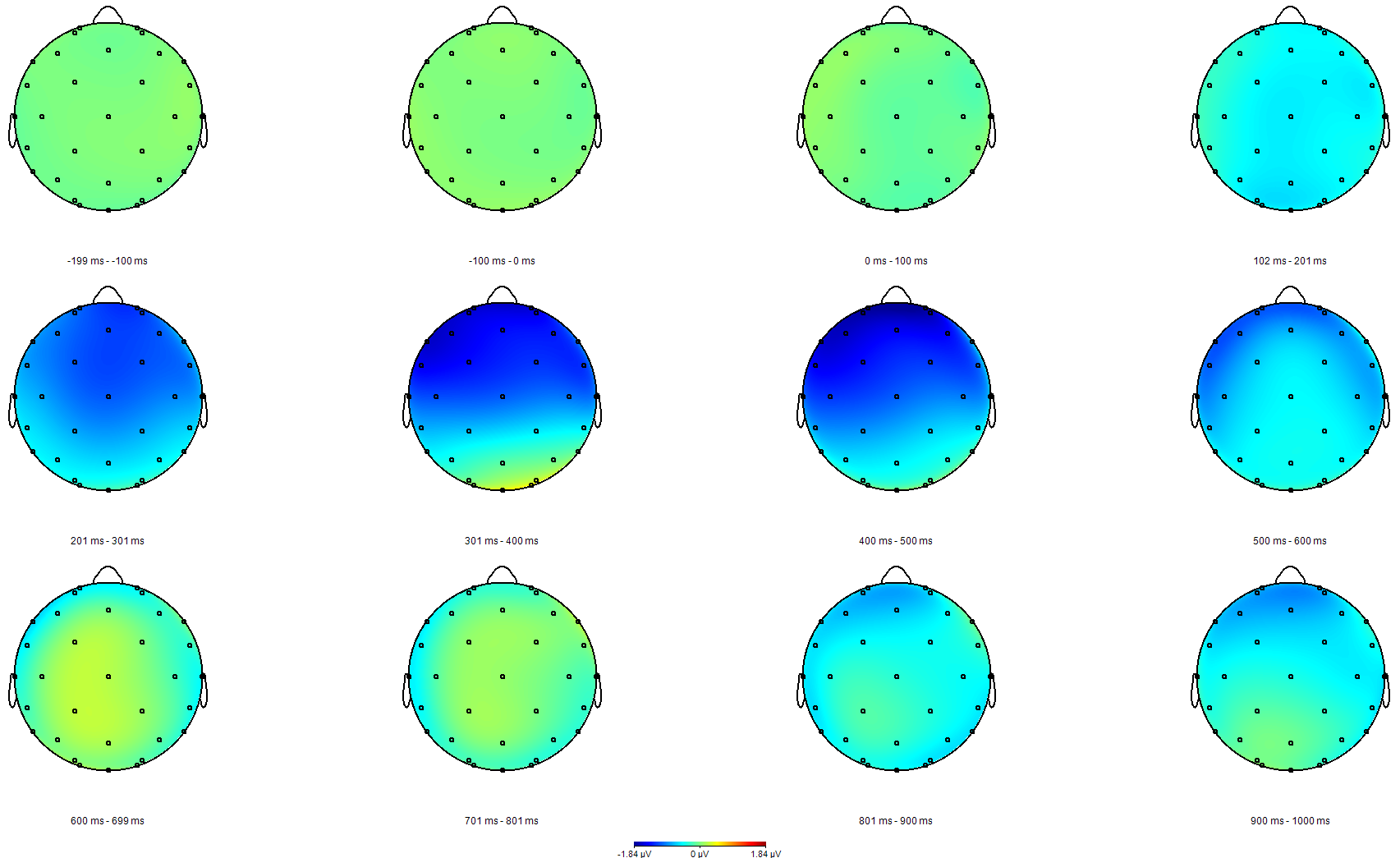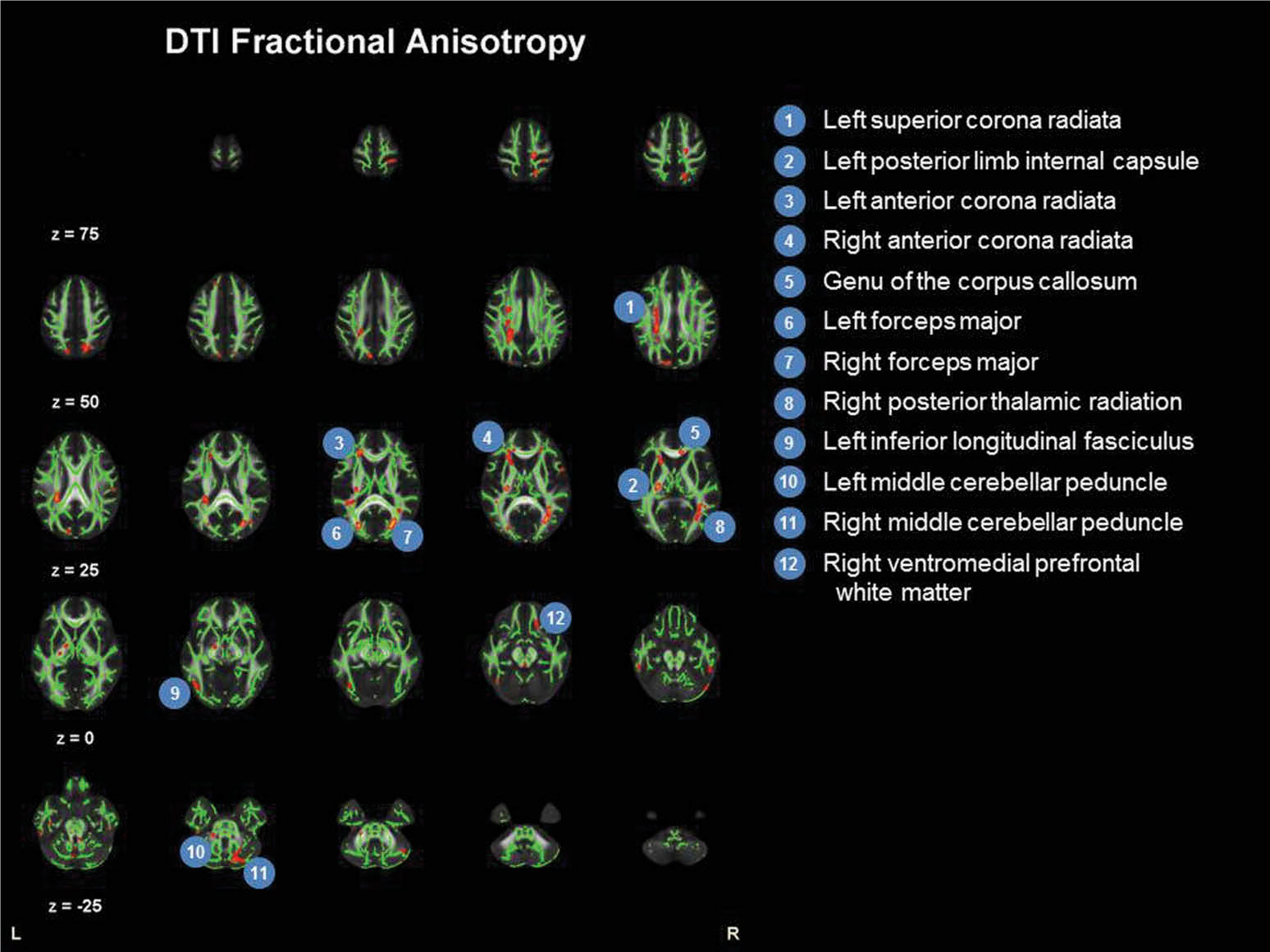B.R.A.I.N. Research Projects
 In the first, pilot, study we are examining whether the CHAT protocol can shift processing of primary language functions (phonology, morphology, syntax, and semantics) to the right hemisphere in non-injured adults. This research is conducted in partnership with Dr. Brian Gonsalves, Dept. of Psychology, Cal State East Bay.
In the first, pilot, study we are examining whether the CHAT protocol can shift processing of primary language functions (phonology, morphology, syntax, and semantics) to the right hemisphere in non-injured adults. This research is conducted in partnership with Dr. Brian Gonsalves, Dept. of Psychology, Cal State East Bay.
For a poster on early results of pilot testing on individuals without aphasia, go HERE.
As of October 2022, 12 men and 19 women have completed the study. Here are their post-training minus pre-training topographical difference maps:
Women's Data:

Men's Data:

Current student research collaborators include: Jiana Brandt, Chelsea Miller, Favi Morfin-Chavez, Yesenia Mendez, Kylie Kelleher, Connie Roth, and Mikhail Crosby. Alumni who worked on this project include: Theresa Jingyun Yao, Sarah Millar, Kendall Finch, Jesse Leben-Wolf, Regina Monteiro, Madeleine Mountain, Amy Marshall, and Clara Baldwin.
The second study, currently in design, will implement the CHAT protocol in a single-subject A-B-A design to determine whether or not CHAT can elicit improved language functions in chronic severe aphasia by shifting primary language processing to the right hemisphere.
Current student research collaborators include: Jiana Brandt, Chelsea Miller, Favi Morfin-Chavez, Yesenia Mendez, Kylie Kelleher, Connie Roth, and Mikhail Crosby. Alumni who worked on this project include: Amy Marshall.
Downstream projects will seek to determine which would better facilitate language improvement for post stroke aphasia in general – targeting the hemisphere containing the lesion, or the contralateral (non-injured) hemisphere; this may depend on the size, location, and severity of the stroke.
This research is made possible by generous research grants for faculty (Faculty Support Grant) and students from the Office of Research and Sponsored Projects and the Center for Student Research, Cal State East Bay.
Co-op group treatment of aphasia has been around for many years. It has been central to the Aphasia Treatment Program of the Rees Speech, Language, and Hearing Clinic at Cal State East Bay, under the direction of Professor Emerita Dr. Jan Avent and subsequently Ellen Bernstein-Ellis. In such a model, two individuals with aphasia form a treatment dyad in which one person functions as the “coach” (or “facilitator”) and the other as the “player” (or “recaller”), in a story-retelling task. The player attempts to retell the story, while the coach provides cueing, correction, or adds missed details. The two then swap roles for the next story.
In the present work, we have replaced the story retelling task with Semantic Feature Analysis, Verb Network Strengthening Training, or Attentive Reading with Constrained Summarization. Each of these is an aphasia intervention with a strong evidentiary basis for individualized aphasia therapy. Here the aim is to determine whether or not they can be successfully implemented in a dyadic cooperative group treatment model.
Student research collaborators include: Lynsie Erickson, Hazel (Jinglan) Li, Alex Enscoe, Megan LaMantia-Bishop, and Sukhjiven Dhesi. Posters presented at ASHA 2018: VNeST, ARCS.
This research is made possible by generous research grants for faculty and students from the Office of Research and Sponsored Programs, Cal State East Bay.

There is a great need for clinical research in the area of cognitive rehabilitation treatment (CRT) for the cognitive impairments that are commonly experienced after Traumatic Brain Injury (TBI), particularly during the chronic phase of recovery. Therefore, we are investigating the ways in which a high-intensity regimen of evidence-based CRT protocols affect brain structure and function, reflecting treatment-induced neuroplasticity in brain networks that are believed to subserve cognitive processes such as attention, memory, and executive function.
For the initial single case study, see Ramanathan, Turner, & Stevens (2019). This study constituted Heather Turner’s master’s thesis at the University of Connecticut (UConn), and was conducted in partnership with Dr. Michael C. Stevens, Olin Neuropsychiatry Research Center (ONRC) of The Institute Of Living, Hartford Hospital, and with funding from UConn, and complimentary neuroimaging by ONRC.
In Spring 2022, a modified version of the above study was completed as a single-subject pilot project to develop materials and methods. One individual with severe chronic TBI completed 40 hours of intensive evidence-based CRT. A robust set of treatment materials, and data collection methods, were developed. Additionally, programs in E-Prime were written to capture event related potential (ERP) measures using the Attention Network Test (ANT; Fan et al., 2009) and a cognitive switching task (Gajewski & Falkenstein, 2012). Qualitative inteview was completed, and psychometric, and psychosocial data were also collected. The EEG/ERP work was completed in the electrophysiology lab of Dr. Brian Gonsalves, Dept. of Psychology, CSU East Bay.
Student research assistants who have worked on this project include: Mikhail Crosby, Jessica Myngheer, Chloris Li, Medha Lohani, Connie Roth, and Soujanya Konatalapalli.
Several grants have supported this line of research. A $33K grant from the Firedoll Foundation provided student research scholarships, support for materials and participant compensation, and summer salary. The CSU East Bay Office of Research and Sponsored Projects and the Center for Student Research provided funding to students and the PI.
Research into executive function and metacognition has proceeded largely independently, particularly in terms of their hypothesized constituent cognitive processes and the manner in which these have been measured. Research in executive function typically employs psychometric tests to evaluate such cognitive processes as verbal fluency, working memory, sequencing, switching, inhibitory control, error detection, planning, and organization. Conversely, metamemory research employs such empirical measures as Feeling of Knowing, Judgments of Learning, and Retrospective Confidence Judgments.
Here we investigated the relationships between executive functions and Judgments of Learning (JOLs), in neurologically normal controls and individuals with TBI.
This research is in collaboration with Dr. Ming-Hui Chen, department of statistics at the University of Connecticut, and (then) doctoral student Dr. Ran Liu, now at AbbVie laboratories.
A manuscript was published in 2021 in Neuropsychological Rehabilitation, and is available on line:
https://www.tandfonline.com/eprint/VBEE6RE2YTYK7UBRWSNX/full?target=10.1080/09602011.2021.1929345
Citation:
Ramanathan, P., Chen, M., Liu, R., & Kennedy, M.R. (2021). Memory and executive functions subserving Judgments of Learning: Cognitive reorganization after traumatic brain injury. Neuropsychological Rehabilitation. https://doi.org/10.1080/09602011.2021.1929345
Here we examine priming/antipriming in visual object identification, and priming/antipriming of metamemory judgments, through behavioral experimentation with normal and disordered populations. There is initial evidence that the judgments that TBI survivors make about the likelihood of remembering word-associations may be influenced by implicit factors; antipriming in particular seems to reduce TBI survivors’ overconfidence in learning, while non brain injured participants remain well calibrated (i.e.: not over-confident). See Ramanathan, Kennedy, & Marsolek (2014). However, this result needs to be replicated.
Currently, we are replicating this study in a larger sample of non-brain injured healthy adult controls; data collection is complete and analyses are underway. For preliminary results, see our poster HERE.
Student research collaborators include two former doctoral students at UConn (Dr. André Lindsey, and Deb Brom), undergraduate research assistants at UConn (including: Evan Shuris, Jenine Entwistle, Jillian Kowalski, Rosamaria Didiano, Disha Patel), and at Cal State East Bay (Theresa Jingyun Yao).
This research has been made possible by a faculty start-up grant at UConn, and generous research grants for faculty from the Office of Research and Sponsored Projects, Cal State East Bay.
Judgments of learning (JOLs) are judgments people make about the likelihood that they will later remember what they are currently learning. Prospective memory (PM) refers to the ability to remember to do something in the future. We are investigating the relationship between people’s JOLs and their PM skills. That is, for example, are people who are able to accurately predict their future recall of information that they are currently learning also good at remembering to do something at a future point in time? And how might TBI affect such relationships.
This work is being done in collaboration with Dr. Sarah Raskin, Trinity College, and student research collaborator Marissa Stein (as part of her undergraduate research) ResearchGate link.
 A visual object identification task has been instantiated in an artificial neural network, following the paradigm of Marsolek, Deason, Ketz, Ramanathan, Bernat, Steele, Patrick, Verfaellie, & Schnyer (2010), in order to examine whether objects need to be sufficiently similar for antiprimimg to occur, and whether the identification errors that are produced when a test object has been antiprimed can be predicted by neurocomputational models of the object identification system. The goal is to more clearly characterize why antipriming accompanies repetition priming.
A visual object identification task has been instantiated in an artificial neural network, following the paradigm of Marsolek, Deason, Ketz, Ramanathan, Bernat, Steele, Patrick, Verfaellie, & Schnyer (2010), in order to examine whether objects need to be sufficiently similar for antiprimimg to occur, and whether the identification errors that are produced when a test object has been antiprimed can be predicted by neurocomputational models of the object identification system. The goal is to more clearly characterize why antipriming accompanies repetition priming.
This work is in collaboration with Drs. Rebecca Deason and Carmen Westerberg of Texas State University, Dr. Nicholas Ketz (University of Colorado), and the late Dr. Chad Marsolek (University of Minnesota).